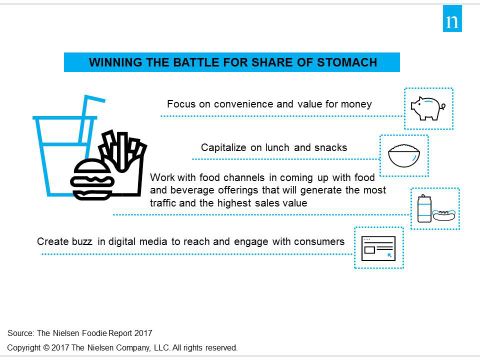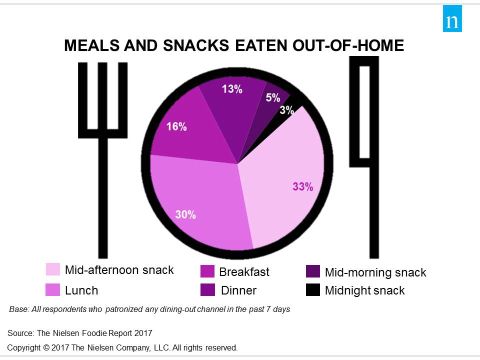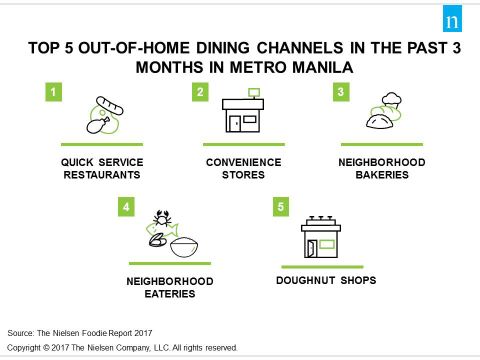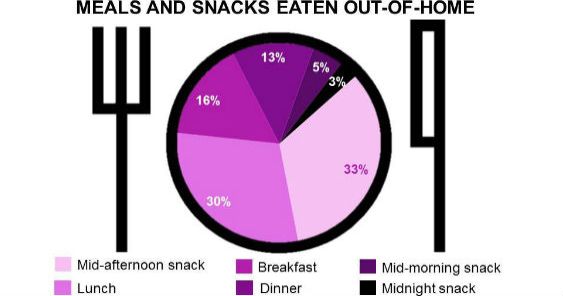MANILA – Eating out of home is increasingly becoming a normal routine, at least in Metro Manila, where consumers claim they dine out-of-home about 42 times in a month or roughly more than once a day, according to the latest report by performance management company, Nielsen.
The Nielsen Foodie report polled respondents in Metro Manila to understand consumers’ out-of-home dining behaviors and preferences. The report examined respondents’ self-reported frequency of eating out of home (includes snacks, dining in, delivery, and take out), their preferred food establishments, and their most important selection factors when choosing where to eat or buy food.
Mid-day and afternoon diners
Lunch and afternoon snacks are the most commonly eaten meals away from home (See chart 1), and for consumers who are time-strapped and on the go, where and what to eat is a perennial question they have to answer day in and day out. Respondents claim that in a month, they frequent five or more different types of eating channels. Quick service restaurants, convenience stores, neighborhood bakeries or bakeshops, and eateries or “carinderias” are the most popular dining-out establishments, with respondents eating or buying food from these places with varying frequency from once a week to almost daily (See chart 2).
“Among the commonalities of these food channels are their accessibility to the home or the work area, their offer of convenience, and value for money. Usually, in these establishments, it is faster for consumers to eat and go or just grab and go. Consumers would also usually eat or buy meals on their way home or to work or while at work and when they do they look for places where they can get their pesos’ worth,” observes Stuart Jamieson, managing director of Nielsen Philippines and Emerging Markets Southeast Asia Cluster leader.
Convenience stores are capitalizing on the opportunities afforded by on-the-go lunch seekers and afternoon snackers by offering a variety of choices and introducing pre-cooked packed meals which can be heated in the store either to be taken out or eaten in the premise.
However, with the worsening traffic situation in Metro Manila, even preparing and eating home-cooked meals during dinner time could prove to be more of a challenge in the future, according to focus group discussion participants who were interviewed for the report. This can pave the way for growth for outlets such as rotisserie/lechon/barbecue stalls, food carts and kiosks.
According to the report, pricier outlets such as casual dining or sit-down restaurants, buffets and eat-all-you-can channels still tend to be patronized less frequently, mostly during special occasions.
“As the incidence of eating out of home increases, we could expect an effect on consumers’ household purchases especially of items used in cooking such as fresh ingredients, sauces, and condiments,” says Jamieson. “Manufacturers can compensate for what could be lost at the household level by tapping into the growing patronage of these neighborhood food establishments. Work with these channels to come up with food, beverage, and dessert offerings for consumers.”
Menu of information sources
TV (i.e. ads, promotion on shows) continue to be an important source of awareness when consumers look for new places to eat. Word of mouth and store display also placed high in respondents’ repertoire of information sources. On the other hand, social media along with feature stories in other online sources such as food blogs and food reviews are gaining traction among the internet-savvy younger generation.
“For startup dining places with lesser budgets to invest in TV commercials or billboards, word of mouth and creating buzz online through blogs and reviews are practical alternatives because they are also potent sources of awareness and information especially among Millennials (aged 16-35 years old). In fact, four in 10 respondents belonging to the age group claimed the highest reliance on online food blogs compared to the more mature respondents,” shares Jamieson.
Nielsen shares these key recommendations for manufacturers and food establishments through an infographic:

Chart 1. Meals and snacks eaten out-of-home

Chart 2. Top 5 Out-of-home dining channels that consumers patronize at least once in the past three months in Metro Manila









